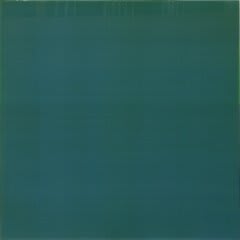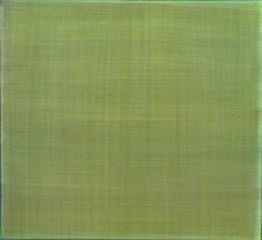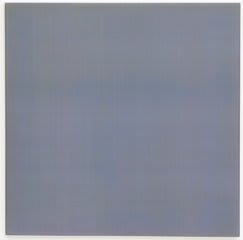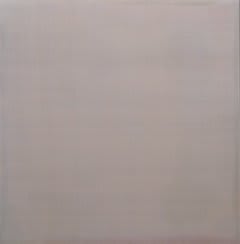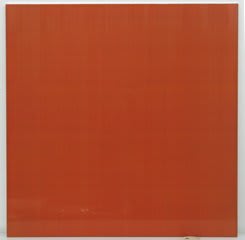John Andrews: Reflections on Painting
John Andrews has always created art within the prescribed limits of the grid. He has previously worked with black wax surfaces modified by rows of penetrating dots filled with pigment, and, more recently, aluminum panels coated with layers of encaustic glazes. His new work continues his trajectory, from opacity to transparency, from black and white to color, from predetermined process to improvisation.
In these frankly beautiful and sensual works, Andrews continues to employ layers of color on aluminum panels, but has changed his medium from encaustic to alkyd. He incorporates small amounts of dried pigment into the medium, working with as many as 100 layers on a panel. These transparent “washes” allow the viewer to see through the paint, down to the original layer. Andrews has introduced sparse amounts of metallic and interference pigments to enliven the interaction of light within the paintings. He also tellingly incorporates personal and fleeting experiences of natural light in the decision-making process of painting. The result is a modulated color field both transparent and veiled, which changes slightly in different light or viewing angles. In often-surprising combinations, mixtures of brilliant and subtle pigments refer to natural and unnatural colors. Though emphatically material and self-contained, these paintings evoke evanescent experience.
-
 John Andrews08-4, 2008alkyd on aluminum18.25 x 18.25 x .5 inches
John Andrews08-4, 2008alkyd on aluminum18.25 x 18.25 x .5 inches
46.4 x 46.4 x 1.3 cms -
 John Andrews08-11, 2008alkyd on aluminum30 x 30.25 x .5 inches
John Andrews08-11, 2008alkyd on aluminum30 x 30.25 x .5 inches
76.2 x 76.8 x 1.3 cms -
 John Andrews08-9, 2008alkyd on aluminum18.25 x 18.25 x .5 inches
John Andrews08-9, 2008alkyd on aluminum18.25 x 18.25 x .5 inches
46.4 x 46.4 x 1.3 cms -
 John Andrews08-8, 2008alkyd on aluminum18.25 x 18.25 x .5 inches
John Andrews08-8, 2008alkyd on aluminum18.25 x 18.25 x .5 inches
46.4 x 46.4 x 1.3 cms -
 John Andrews08-3, 2008alkyd on aluminum18.25 x 18.25 x .5 inches
John Andrews08-3, 2008alkyd on aluminum18.25 x 18.25 x .5 inches
46.4 x 46.4 x 1.3 cms -
 John Andrews08-6, 2008alkyd on aluminum18.25 x 18.25 x .5 inches
John Andrews08-6, 2008alkyd on aluminum18.25 x 18.25 x .5 inches
46.4 x 46.4 x 1.3 cms -
 John Andrews08-5, 2008alkyd on aluminum18.25 x 18.25 x .5 inches
John Andrews08-5, 2008alkyd on aluminum18.25 x 18.25 x .5 inches
46.4 x 46.4 x 1.3 cms -
 John Andrews08-10, 2008alkyd on aluminum18.25 x 18.25 x .5 inches
John Andrews08-10, 2008alkyd on aluminum18.25 x 18.25 x .5 inches
46.4 x 46.4 x 1.3 cms -
 John Andrews08-12, 2008alkyd on aluminum30 x 30.25 x .5 inches
John Andrews08-12, 2008alkyd on aluminum30 x 30.25 x .5 inches
76.2 x 76.8 x 1.3 cms -
 John Andrews08-13, 2008alkyd on aluminum panel36 x 36 x .5 inches
John Andrews08-13, 2008alkyd on aluminum panel36 x 36 x .5 inches
91.4 x 91.4 x 1.3 cms




